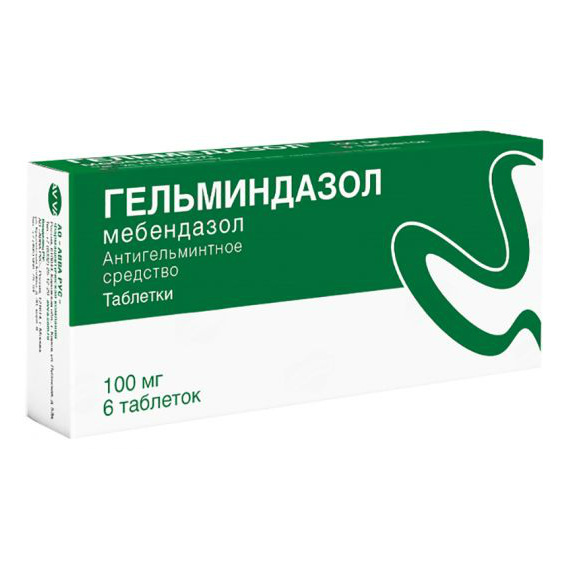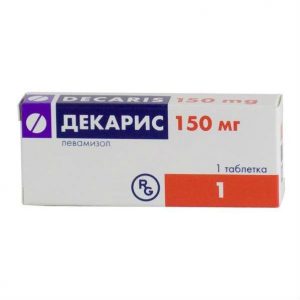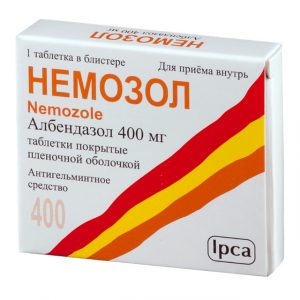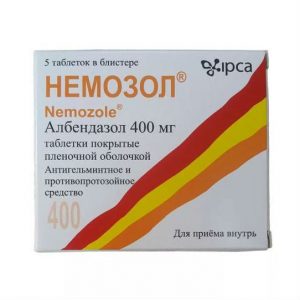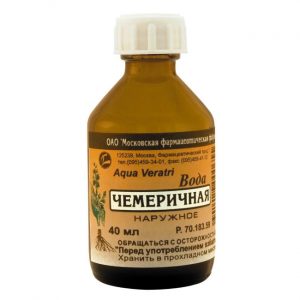Description
Pharmacological action
Helmindazolol is a broad-spectrum anthelmintic drug that is most effective in enterobiasis and trichocephalosis. Causing an irreversible violation of glucose utilization, depletes glycogen stores in helminth tissues, interferes with the synthesis of cell tubulin, and inhibits ATP synthesis.
Indications
Enterobiosis, ascariasis, hookworm infection, strongyloidosis, trichocephalosis, trichinosis, teniosis, echinococcosis, multiple nematodes, alveococcosis, capillary disease, gnatostomiasis, mixed helminthiasis.
Contraindications
Hypersensitivity to Mebendazole, ulcerative colitis, Crohn’s disease, liver failure, childhood (up to 2 years), pregnancy, lactation.
Special instructions
The drug contains lactose, therefore, this drug is contraindicated in patients with rare hereditary lactose intolerance, lactase deficiency or impaired absorption of glucose / galactose.
In patients with diabetes mellitus, it is necessary to control the concentration of glucose in the blood plasma.
With prolonged use, it is necessary to control the picture of peripheral blood, the function of the liver and kidneys.
During the day after administration, the use of ethanol, fatty foods, and the use of laxatives is prohibited.
Be sure to periodically examine smears of the anal area and feces after treatment: therapy is considered effective in the absence of helminths or their eggs for the next 7 days.
The results of a study of the development of Stephen-Johnson syndrome and toxic epidermal necrolysis indicate a possible relationship between their occurrence and the simultaneous use of mebendazole and metronidazole. There is no other data documenting cases of such drug interactions. That is why the simultaneous use of mebendazole and metronidazole should be avoided.
Effect on the ability to drive vehicles and mechanisms
Patients should be careful when driving vehicles and working with equipment, as during treatment dizziness and drowsiness may occur.
Composition
Active ingredient: mebendazole (in terms of 100% substance ) – 100.0 mg.
Excipients: corn starch – 72.0 mg, colloidal silicon dioxide – 3.0 mg, talc – 3.0 mg, magnesium stearate – 3.0 mg, crospovidone – 3.0 mg, sodium lauryl sulfate – 0.5 mg , lactose monohydrate – to obtain tablets weighing 300.0 mg.
Dosage and administration
Inside with a little water.
Adults and children over 3 years of age.
With enterobiasis – once at 100 mg / day (1 tablet), the course of treatment is 1 day. Since reinfection with enterobiasis is quite common, treatment should be repeated after 2 and 4 weeks.
It is recommended that all family members be treated concurrently.
With ascariasis, trichocephalosis, hookworm and mixed helminthiases: 200 mg / day (1 tablet in the morning, 1 tablet in the evening), the course of treatment is 3 days.
With teniosis, strongyloidosis. Adults: 400 mg / day (2 tablets in the morning, 2 tablets in the evening), the course of treatment is 3 days. Children over 3 years: 200 mg / day (1 tablet in the morning, 1 tablet in the evening), the course of treatment is 3 days.
With echinococcosis. Adults and children over 14 years of age: in the first three days, 500 mg 2 times a day, in the next 3 days, the dose is increased to 500 mg 3 times a day, then the dose is increased to 1000-1500 mg 3 times a day. The average duration of treatment for echinococcosis caused by Echinococcus granulosis is 4-6 weeks, caused by Echinococcus multilocularis – up to two years.
With trichinosis on the 1st day 3 times a day, 200-300 mg, on the 2nd day 4 times a day, 200-300 mg, and from 3 to 14 days – 3 times a day, 500 mg.
Side effects
Allergic reactions: skin rash, urticaria, angioedema, Steven-Johnson syndrome, toxic epidermal necrolysis, exanthema, anaphylactic and anaphylactoid reactions.
From the hemopoietic organs: neutropenia.
From the digestive system: nausea, vomiting, abdominal pain, diarrhea, increased activity of hepatic transaminases, alkaline phosphatase, hepatitis (when used in high doses for a long time).
From the nervous system: dizziness, headache, drowsiness, cramps.
From the urinary system: hypercreatininemia, glomerulonephritis (when used in high doses for a long time).
Other: hair loss (when used in high doses for a long time).
Overdose
Symptoms: abdominal pain, nausea, vomiting, diarrhea. When used in high doses for a long time: reversible liver dysfunction, hepatitis, neutropenia.
Treatment: it is necessary to remove the drug from the stomach, causing vomiting or gastric lavage, taking activated charcoal, symptomatic therapy.
Storage conditions
In a place protected from moisture and light at a temperature not exceeding 25 ° C.
Keep out of the reach of children.
Expiration
2 years.
Deystvuyuschee substances
mebendazole
Conditions of release from drugstores
Prescription of ppdro6550 Terms and conditions of vocational
